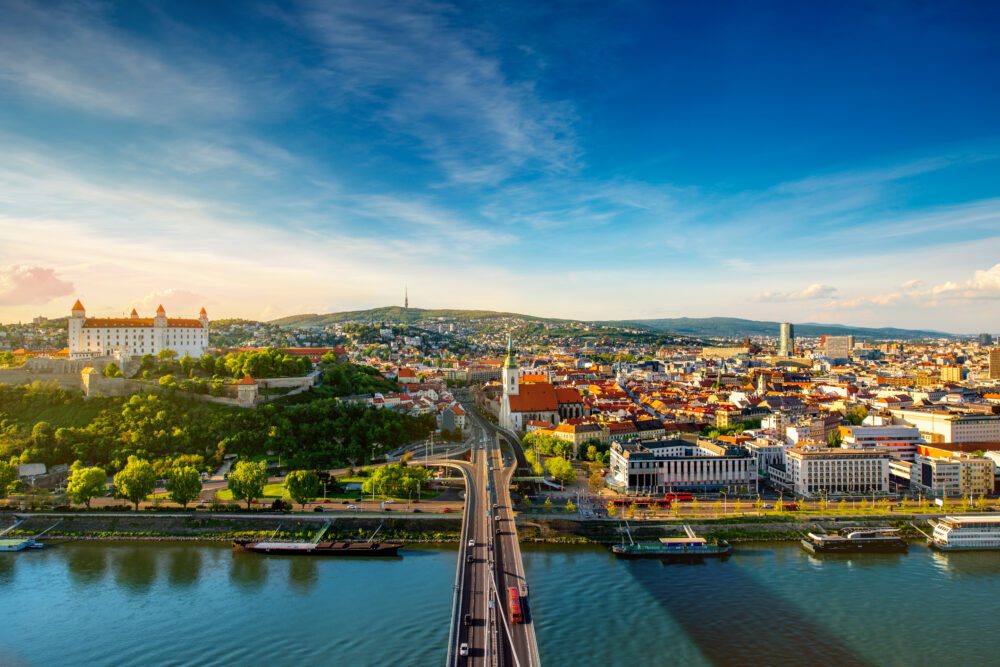
Introduction
Nestled along the banks of the mighty Danube River, Bratislava stands as a hidden gem waiting to be explored in the heart of Europe. As the capital city of Slovakia, Bratislava exudes a unique charm that effortlessly blends its rich history with modern sophistication. With its cobblestone streets, medieval castles, and picturesque Old Town, Bratislava offers visitors a journey back in time, where tales of kings, queens, and centuries-old traditions come to life. From its stunning architectural landmarks to its vibrant cultural scene and lush green spaces, Bratislava boasts a diverse array of attractions that make it a captivating destination for travellers seeking to uncover the hidden treasures of Eastern Europe.
With a history dating back over a millennium, Bratislava has served as a crossroads of cultures and civilizations, leaving behind a legacy of fascinating stories and landmarks to explore. Once a key player in the Hungarian Kingdom and later the capital of the Kingdom of Hungary, Bratislava’s strategic location along trade routes made it a bustling centre of commerce and culture. Today, remnants of its storied past can be found around every corner, from the imposing Bratislava Castle overlooking the city to the charming streets of the Old Town, where medieval fortifications and Baroque facades transport visitors back in time. With its vibrant arts scene, thriving culinary culture, and welcoming atmosphere, Bratislava offers travellers an unforgettable journey into the heart of Slovakia’s rich heritage and modern-day charm.
Table of Contents
Map of the Best Things to Do in Bratislava
Bratislava Old Town
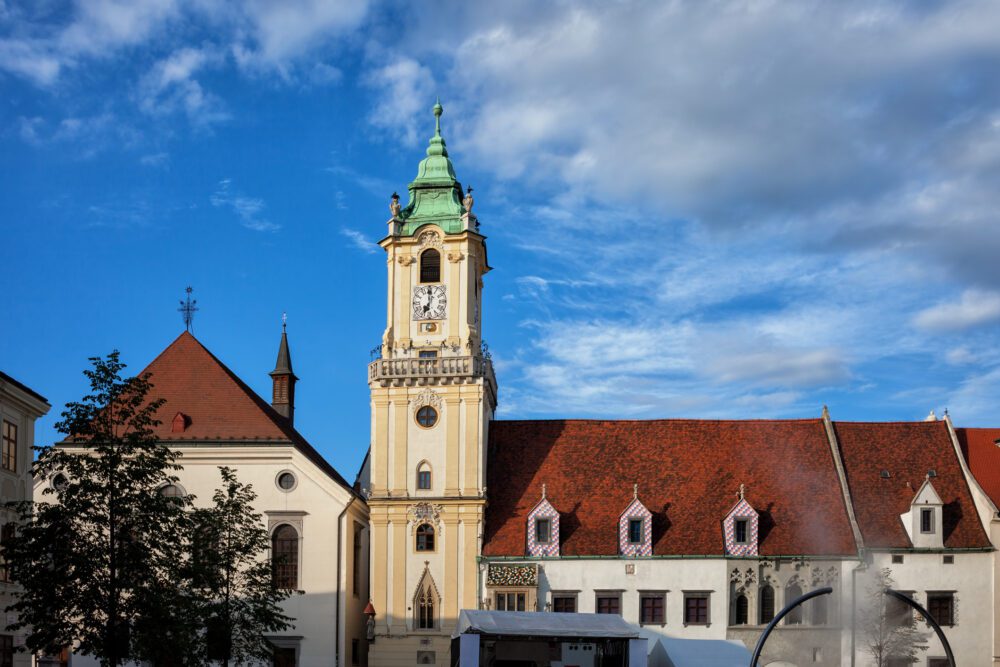
Bratislava’s Old Town stands as a testament to the city’s rich history and cultural heritage, with its narrow cobblestone streets, charming squares, and beautifully preserved historic buildings. Dating back to the Middle Ages, the Old Town served as the heart of Bratislava’s economic and social life, and today it remains a vibrant hub bustling with activity. Visitors can wander through its winding alleys, admiring the elegant facades of centuries-old buildings adorned with colourful frescoes and intricate details. Must-see landmarks in the Old Town include St. Martin’s Cathedral, a stunning Gothic church dating back to the 14th century, and Michael’s Gate, the last remaining medieval city gate that offers panoramic views of the city from its observation deck.
Exploring Bratislava’s Old Town is best done on foot, allowing visitors to fully immerse themselves in its charming atmosphere and discover its hidden gems at their own pace. Be sure to visit the Main Square, where you’ll find the iconic Old Town Hall and the charming Roland Fountain, a symbol of Bratislava’s prosperity and independence. Don’t miss the opportunity to sample traditional Slovak cuisine at one of the many cosy cafes or restaurants lining the streets, offering hearty dishes such as bryndzové halušky (potato dumplings with sheep cheese) and delicious pastries like trdelník (a sweet pastry cooked over an open flame).
Presidential Palace
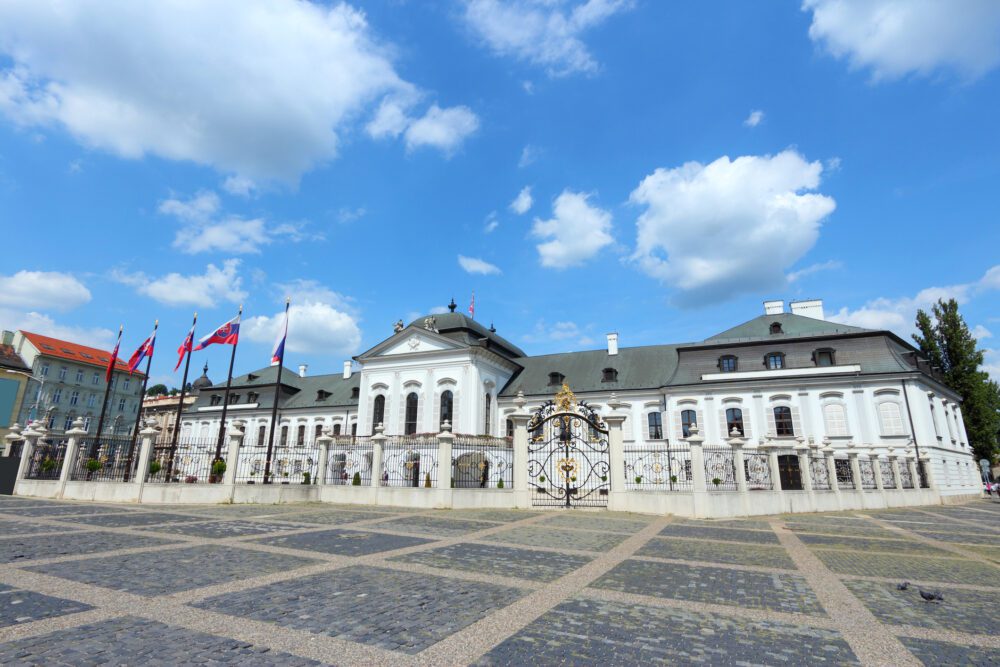
The Presidential Palace, located in the heart of Bratislava, stands as a symbol of the country’s political history and serves as the official residence of the President of Slovakia. Originally constructed in the 18th century as a residence for the Hungarian nobleman Anton Grassalkovich, the palace boasts an impressive Baroque architectural style, characterized by its grand facade, ornate interiors, and sprawling gardens. Over the years, the palace has undergone several renovations and additions, with each iteration adding to its grandeur and significance. Today, visitors can explore the palace’s opulent rooms, adorned with exquisite frescoes, intricate stucco work, and period furnishings, providing a glimpse into the lives of Slovakia’s past rulers.
While the interior of the Presidential Palace is primarily used for official functions and ceremonies, visitors can still admire its stunning exterior and explore the adjacent gardens, which are open to the public. Guided tours of the palace are available at certain times of the year, providing a rare opportunity to learn about the history and significance of this iconic landmark. Additionally, the nearby Grassalkovich Square offers a picturesque setting for leisurely strolls and photography, with its manicured lawns, elegant statues, and serene atmosphere.
Michael’s Gate

Michael’s Gate, one of the most iconic landmarks in Bratislava, is a striking testament to the city’s medieval past. Dating back to the late 14th century, this majestic Gothic tower served as part of the city’s fortifications, designed to protect Bratislava from invaders. Named after the archangel Michael, the patron saint of the city, the gate has undergone various renovations and reconstructions over the centuries but has retained its distinctive character and charm. Today, Michael’s Gate stands as the last remaining medieval city gate in Bratislava and offers visitors a fascinating glimpse into the city’s history and architectural heritage.
Visitors to Bratislava should not miss the opportunity to climb to the top of Michael’s Gate, where they will be rewarded with panoramic views of the city’s skyline and the surrounding countryside. The gate also houses the Museum of Weapons and City Fortifications, where visitors can learn more about the history of Bratislava’s fortifications and view a collection of historical artefacts and exhibits. Additionally, the area surrounding Michael’s Gate is bustling with shops, cafes, and restaurants, making it the perfect place to relax and soak in the atmosphere of Bratislava’s Old Town.
Old Town Hall

The Old Town Hall of Bratislava is a captivating architectural gem nestled in the heart of the city’s historic centre. Dating back to the 15th century, this beautiful Gothic-style building served as the seat of the city’s municipal government for centuries, playing a central role in the governance and administration of Bratislava. Adorned with ornate decorations and intricate details, including a striking clock tower and colourful frescoes, the Old Town Hall is a testament to the city’s rich cultural heritage and medieval past. Today, the building houses the Bratislava City Museum, where visitors can explore exhibitions showcasing the history, art, and culture of the Slovak capital.
Visitors to the Old Town Hall should take advantage of the guided tours offered by the Bratislava City Museum, which provide fascinating insights into the history and architecture of the building. Be sure to climb to the top of the clock tower for panoramic views of the city and the charming streets of the Old Town below. Additionally, the courtyard of the Old Town Hall often hosts cultural events, concerts, and exhibitions, providing a unique opportunity to experience the vibrant arts scene of Bratislava.
St. Martin’s Cathedral
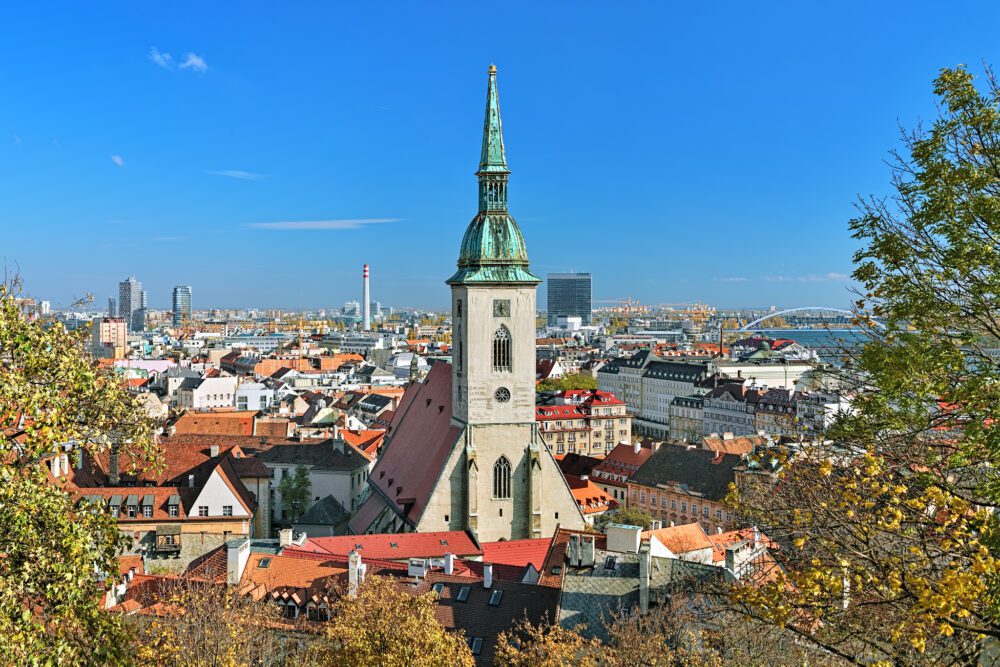
St. Martin’s Cathedral, a stunning Gothic masterpiece, stands as one of the most significant landmarks in Bratislava. Dating back to the 13th century, this imposing cathedral has played a pivotal role in the religious and cultural life of the city for centuries. Its soaring spire dominates the skyline of Bratislava’s Old Town, making it a prominent symbol of the city’s architectural heritage. Over the centuries, St. Martin’s Cathedral has witnessed numerous historic events, including the coronations of Hungarian kings and queens, further cementing its status as a cultural and historical icon. Visitors to the cathedral can marvel at its intricate facade, adorned with intricate carvings and sculptures, and explore its majestic interior, featuring stunning stained glass windows, ornate altars, and beautifully crafted frescoes.
When visiting St. Martin’s Cathedral, be sure to join one of the guided tours offered by knowledgeable local guides, who can provide fascinating insights into the history and significance of this historic landmark. Don’t miss the opportunity to climb to the top of the cathedral’s tower for panoramic views of Bratislava’s skyline and the surrounding Danube River. Additionally, check the cathedral’s schedule for concerts and organ recitals, which often take place within its hallowed walls and offer a unique opportunity to experience the cathedral’s acoustics and ambience.
Bratislava Castle
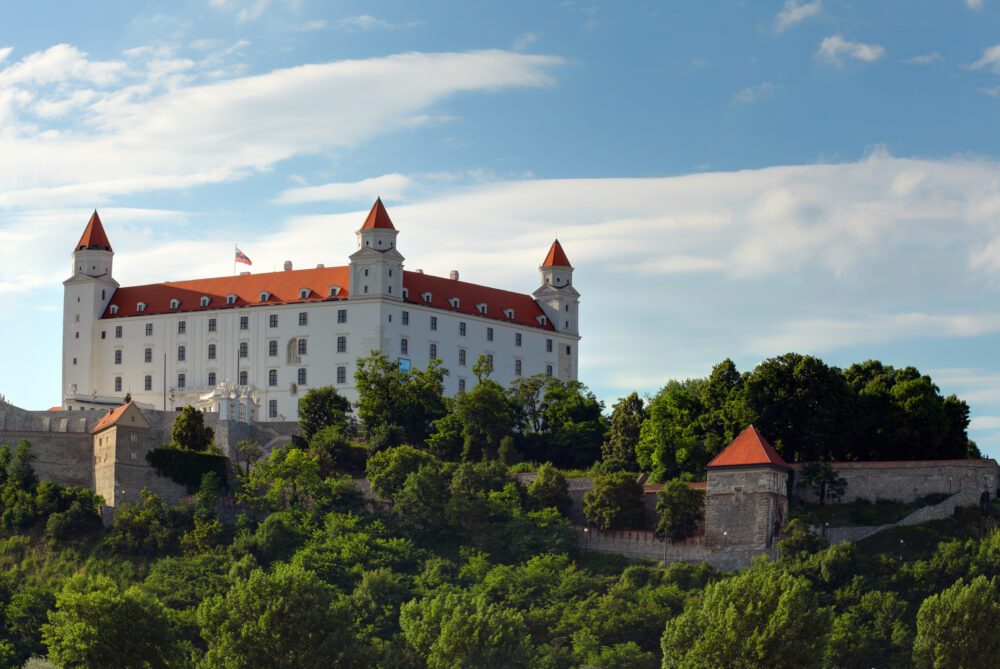
Perched majestically atop a hill overlooking the Danube River, Bratislava Castle stands as a symbol of the city’s rich history and architectural grandeur. Dating back to the 9th century, the castle has undergone numerous transformations over the centuries, reflecting the changing political and cultural landscape of Slovakia. From a medieval fortress to a Renaissance palace and later a Baroque residence, Bratislava Castle has played a central role in the country’s history, serving as the seat of Hungarian kings, emperors, and Slovak rulers. Today, the castle is a popular tourist destination, offering visitors the chance to explore its historic chambers, admire its impressive collections of art and artefacts, and enjoy panoramic views of the city and the surrounding countryside.
When visiting Bratislava Castle, consider taking a guided tour to gain deeper insights into its fascinating history and architecture. Be sure to explore the castle’s interior, which houses exhibitions on the history of Slovakia, as well as galleries showcasing works of art and historical artefacts. Don’t miss the chance to stroll through the castle’s gardens, which offer tranquil spots to relax and take in the picturesque views of the Danube River below. Additionally, check the castle’s schedule for special events and exhibitions, which often showcase the rich cultural heritage of Bratislava and Slovakia.
Slovak National Gallery
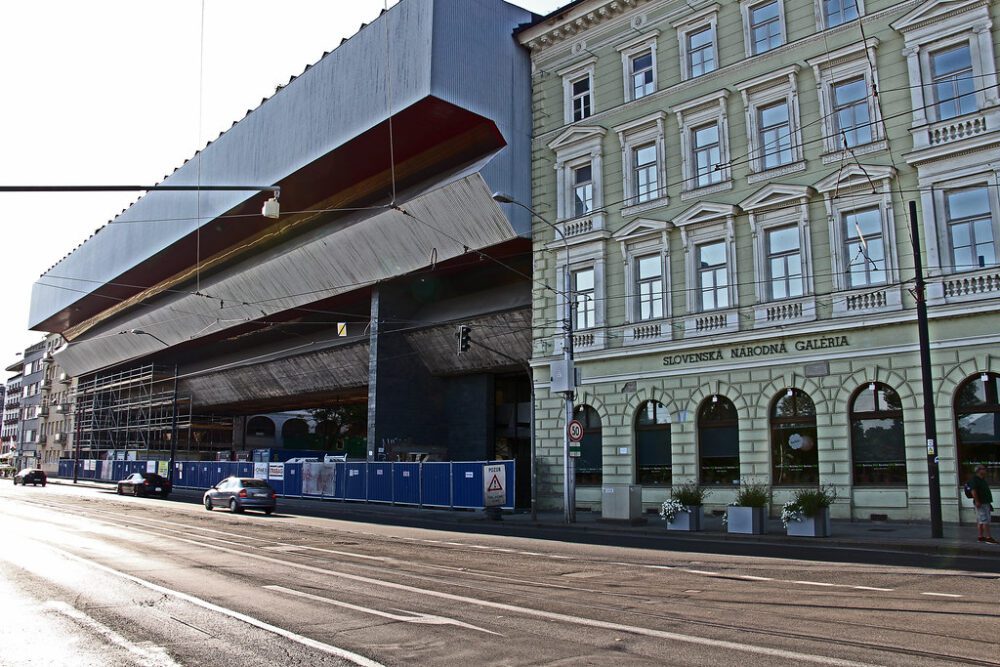
The Slovak National Gallery, housed in a striking neo-Renaissance building in the heart of Bratislava, is a treasure trove of Slovak and Central European art. Established in 1948, the gallery boasts an extensive collection of paintings, sculptures, and other artworks spanning various periods and styles. Visitors can immerse themselves in the rich cultural heritage of Slovakia, with exhibits showcasing works by prominent Slovak artists such as Ľudovít Fulla, Martin Benka, and Mikuláš Galanda, as well as pieces from international artists. From medieval religious art to contemporary masterpieces, the Slovak National Gallery offers a comprehensive overview of the country’s artistic evolution.
When visiting the Slovak National Gallery, consider taking advantage of guided tours or audio guides to enhance your experience and gain deeper insights into the artworks on display. Be sure to explore the various exhibitions spread across the gallery’s multiple floors, including the permanent collections and rotating temporary exhibits. Additionally, check the gallery’s schedule for special events, lectures, and workshops, which provide opportunities to engage with art in a meaningful way.
Blue Church of St Elizabeth
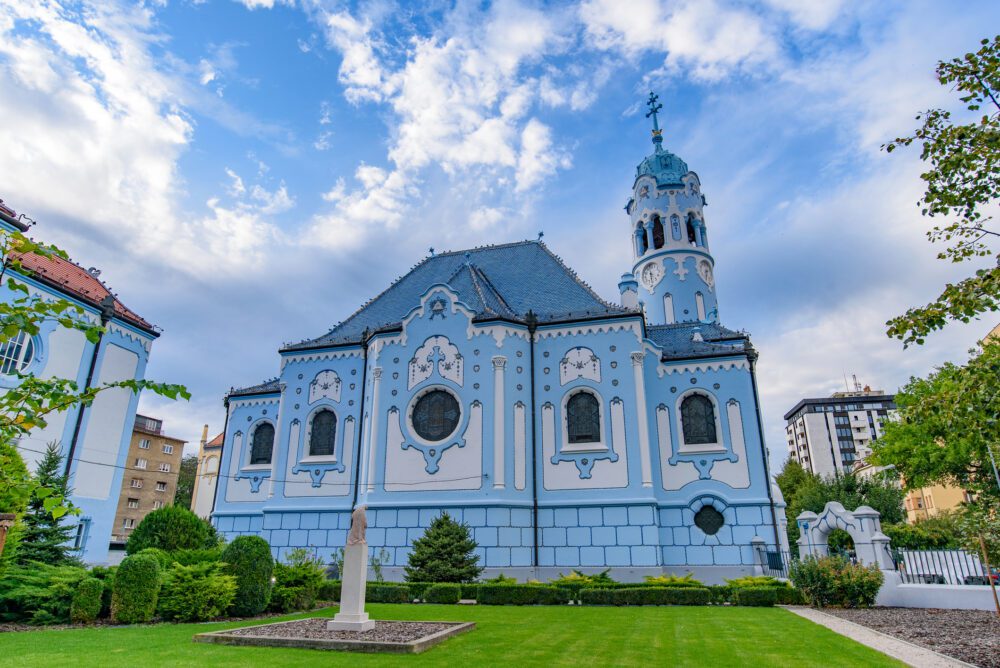
The Blue Church, officially known as the Church of St. Elizabeth, is a charming architectural gem tucked away in the heart of Bratislava’s Old Town. Built-in the early 20th century in the Art Nouveau style, this small but distinctive church captivates visitors with its pastel blue façade adorned with intricate detailing and delicate pastel accents. Designed by Hungarian architect Ödön Lechner, the Blue Church is a testament to the whimsical and romantic spirit of the Art Nouveau movement. Its interior continues the blue theme, with sky-blue walls, azure stained glass windows, and ornate blue-and-gold decorations, creating a serene and ethereal atmosphere.
When visiting the Blue Church, take time to admire its exterior from all angles to fully appreciate its unique architectural features and delicate craftsmanship. While the church’s interior is usually not accessible to the public outside of Mass times, you can still appreciate its beauty from the outside. Consider visiting during daylight hours to see the church bathed in natural light, or visit in the evening when the church is often illuminated, adding to its enchanting allure. Don’t forget to bring your camera to capture the Blue Church’s picturesque beauty, which makes for a stunning backdrop for photographs in Bratislava’s historic city centre.
Slovak National Theatre
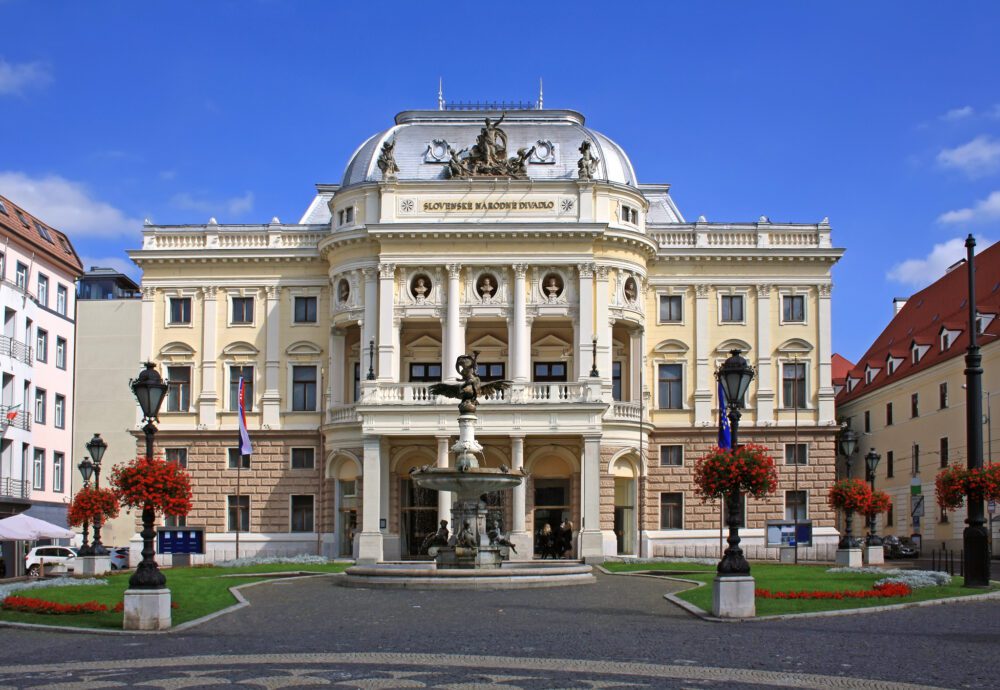
The Slovak National Theatre stands as a cultural beacon in Bratislava, showcasing the nation’s rich theatrical heritage and artistic prowess. Established in 1920, the theatre has played a central role in shaping Slovakia’s performing arts scene, hosting a diverse range of productions including opera, ballet, drama, and musical performances. Its historic building, situated on the banks of the Danube River, is an architectural masterpiece in its own right, blending Neo-Renaissance and Neo-Baroque elements to create a grand and imposing facade. Inside, visitors are treated to opulent interiors adorned with intricate decorations, ornate chandeliers, and plush seating, providing an elegant setting for theatrical performances of the highest calibre.
To make the most of your visit to the Slovak National Theatre, consider booking tickets in advance for upcoming performances, as popular shows can sell out quickly. Take the opportunity to explore the theatre’s surroundings, with its picturesque location offering stunning views of the river and the city skyline. Additionally, check the theatre’s schedule for guided tours, which provide fascinating insights into its history, architecture, and behind-the-scenes operations.
UFO Bridge & Tower
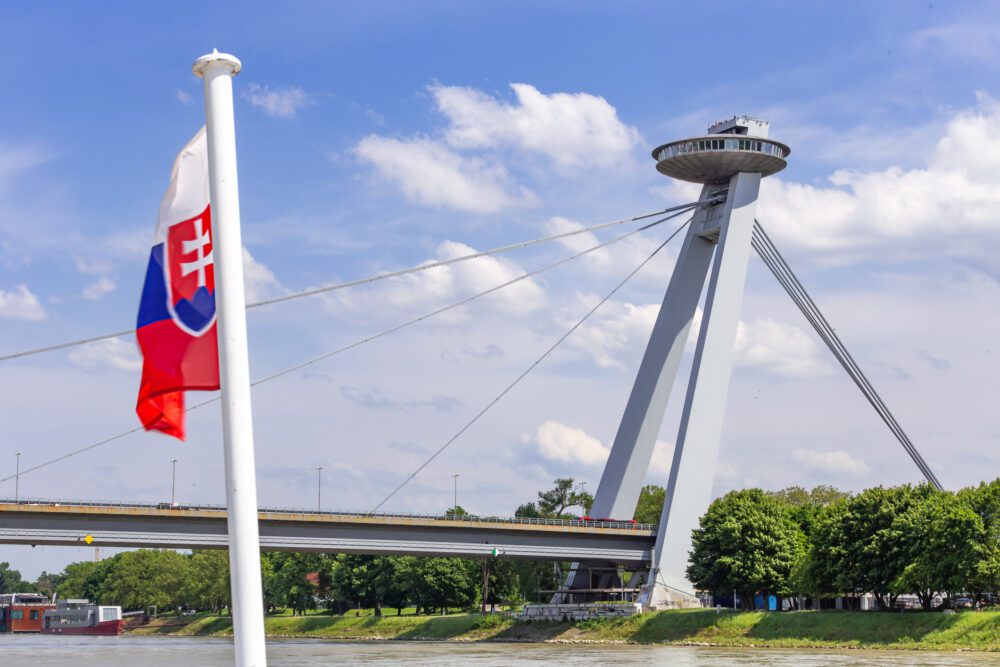
The UFO Bridge, officially known as the Most SNP (Bridge of the Slovak National Uprising), is one of Bratislava’s most iconic landmarks, spanning the Danube River and connecting the Old Town with the Petržalka district. Completed in 1972, the bridge is a testament to Soviet-era engineering and modernist design, featuring a unique asymmetrical pylon that supports its suspended roadway. Atop the bridge’s pylon sits the UFO Tower, a striking observation deck and restaurant that offers panoramic views of the city and the surrounding landscape. Visitors can access the UFO Tower via an elevator ride that ascends to a height of 95 meters, where they can enjoy breathtaking vistas from the observation deck or dine in the rotating restaurant, which completes a full revolution every hour.
To experience the best views of Bratislava from the UFO Tower, consider visiting during the late afternoon or early evening hours to catch the sunset over the city skyline. Be sure to bring your camera to capture stunning photographs of the Danube River, Bratislava Castle, and the historic Old Town from the observation deck. After taking in the scenery, relax and unwind at the UFO Restaurant, where you can indulge in delicious cuisine and refreshing drinks while marvelling at the ever-changing panorama below.
Danube River Cruise
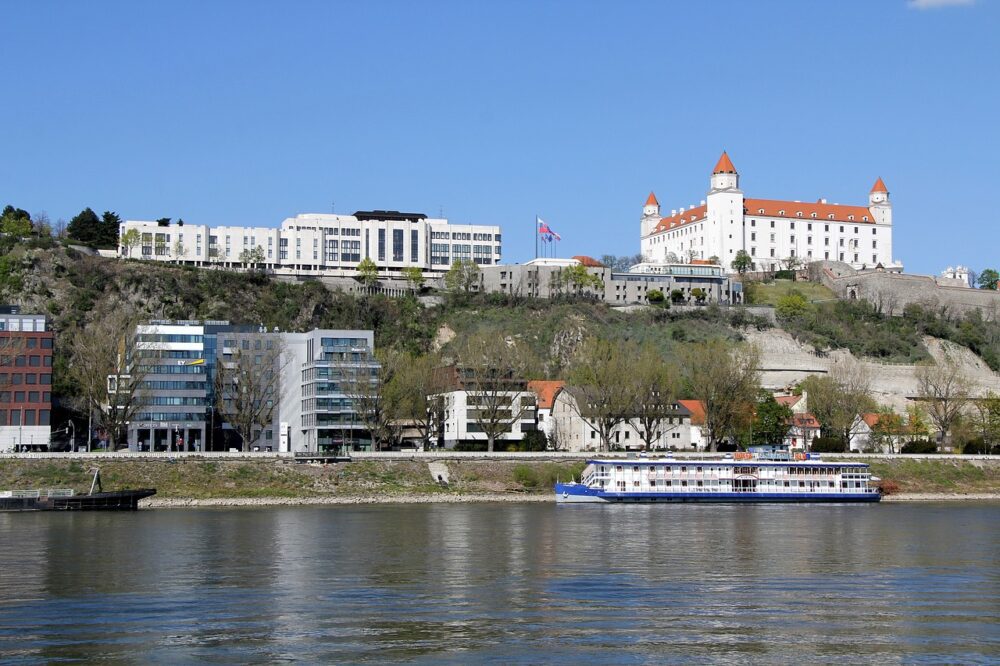
A Danube River cruise offers a delightful way to explore Bratislava’s scenic waterfront and admire its iconic landmarks from a different perspective. The Danube River, one of Europe’s longest and most historic waterways, has played a crucial role in the region’s development and cultural heritage for centuries. Opting for a speed boat tour adds an exhilarating twist to the experience, allowing visitors to cover more ground in less time while enjoying a thrilling ride along the river. As you zip across the water, you’ll pass by historic landmarks such as Bratislava Castle, the UFO Bridge, and the picturesque Old Town, all while soaking in panoramic views of the city’s skyline and natural surroundings.
When booking a speed boat tour of the Danube River, consider opting for an early morning or late afternoon departure to avoid the crowds and enjoy calmer waters for a smoother ride. Be sure to dress appropriately for the weather and wear sunscreen, as you’ll be exposed to the elements during the excursion. Additionally, keep your camera or smartphone handy to capture memorable moments as you glide past Bratislava’s most iconic sights.
Slavin

Perched atop a hill overlooking Bratislava, Slavín is a poignant memorial and military cemetery honouring the Soviet soldiers who perished, liberating the city from Nazi occupation during World War II. Completed in 1960, the monument features a towering obelisk rising 39 meters high, crowned by a bronze statue of a Soviet soldier holding a flag. Surrounding the monument are rows of graves marked by simple white crosses, where over 6,800 Soviet soldiers are laid to rest. The site offers a solemn atmosphere for reflection and remembrance, with panoramic views of the cityscape below. Visitors can ascend the hill via a series of stairs or take a leisurely stroll through the park-like grounds, which are dotted with trees and benches.
To reach Slavín, visitors can take a short taxi ride or enjoy a scenic walk from the Old Town, though be prepared for a steep incline. Plan your visit during the early morning or late afternoon to avoid the midday crowds and enjoy quieter surroundings. Additionally, consider bringing a camera to capture the breathtaking views of Bratislava and the Danube River from the observation platform near the monument.
Bratislava Transport Museum
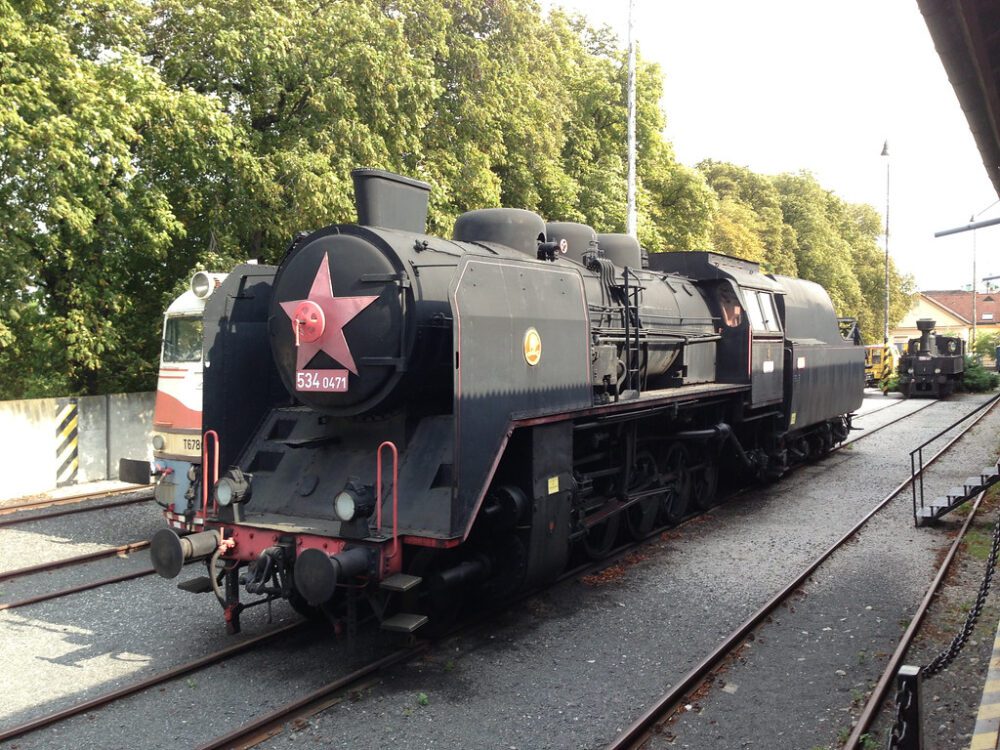
The Bratislava Transport Museum, located in the Slovak capital, is a fascinating destination for enthusiasts of all things automotive and transportation-related. Established in 1999, the museum showcases a diverse collection of vintage vehicles, ranging from classic cars and motorcycles to trams and trolleybuses. Visitors can explore the evolution of transportation in Bratislava and beyond through exhibits featuring meticulously restored vehicles, interactive displays, and historical artefacts. One of the highlights of the museum is its extensive collection of Škoda automobiles, providing insight into the iconic Czech automaker’s contribution to the automotive industry over the years.
When planning your visit to the Bratislava Transport Museum, consider allocating at least a couple of hours to fully immerse yourself in the exhibits and displays. The museum is conveniently located near the city centre and is easily accessible by public transportation or car. Visitors can purchase tickets on-site or in advance online for added convenience. Additionally, be sure to check the museum’s website for any special exhibitions or events taking place during your visit.
Devin Castle
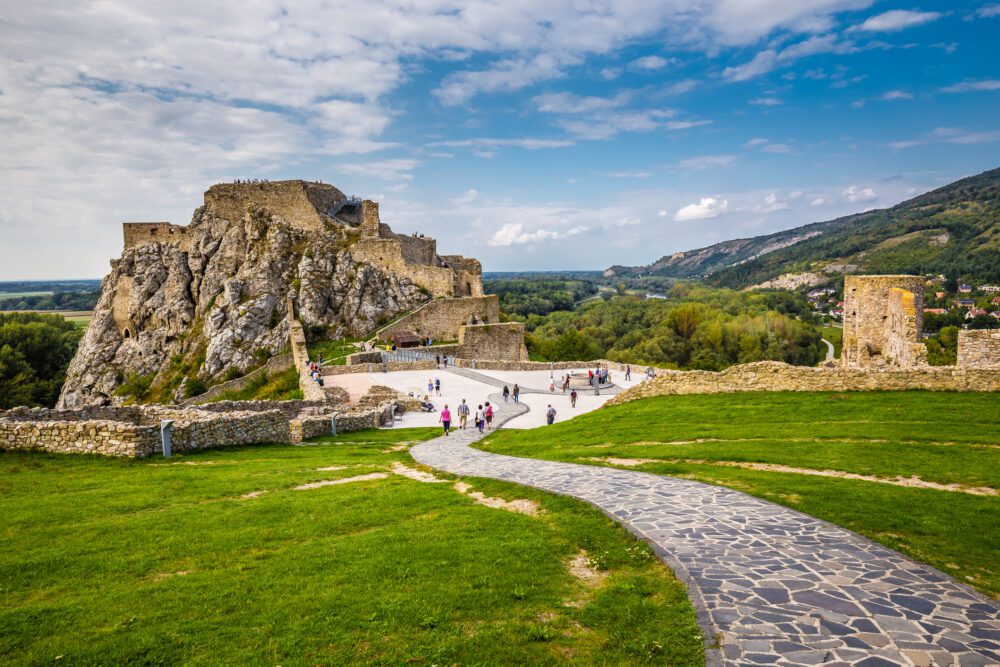
Perched majestically atop a rocky cliff overlooking the confluence of the Danube and Morava rivers, Devin Castle is a historic fortress steeped in centuries of history. Dating back to the 9th century, the castle has played a significant role in the defense of the region and witnessed numerous battles and sieges over the centuries. Today, visitors to Devin Castle can explore the well-preserved ruins, which offer stunning panoramic views of the surrounding landscape and the meandering rivers below. The site features remnants of ancient fortifications, including defensive walls, towers, and gates, as well as archaeological excavations that provide insight into the castle’s rich past.
To make the most of your visit to Devin Castle, consider joining a guided tour to gain a deeper understanding of the site’s history and significance. The castle is easily accessible from Bratislava by bus, car, or even by bike along scenic riverside paths. Be sure to wear comfortable walking shoes, as exploring the castle grounds may involve some uneven terrain and staircases. Don’t forget to bring a camera to capture the breathtaking views from the castle’s vantage points.
Danubiana Meulensteen Art Museum
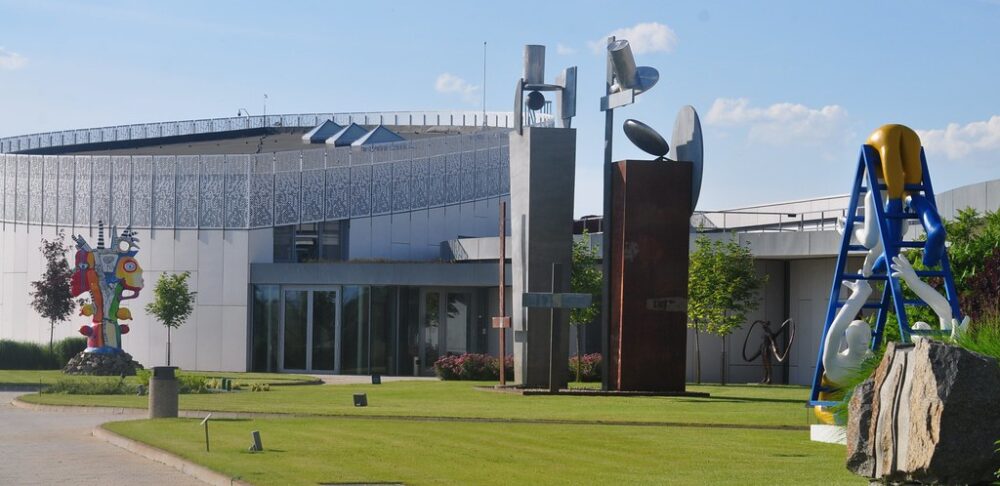
Nestled on a picturesque peninsula along the Danube River, the Danubiana Meulensteen Art Museum is a haven for contemporary art enthusiasts. Established in 2000, the museum showcases a diverse collection of modern and contemporary artworks by Slovak and international artists. The museum’s sleek, minimalist architecture harmonizes with the natural surroundings, creating an immersive experience that seamlessly blends art and nature. Visitors can explore a range of exhibitions featuring paintings, sculptures, installations, and multimedia artworks, all set against the backdrop of the tranquil Danube landscape. With its ever-changing roster of exhibits and events, Danubiana Meulensteen Art Museum offers a dynamic and engaging cultural experience for art lovers of all ages.
When planning your visit to Danubiana Meulensteen Art Museum, consider taking advantage of the museum’s guided tours and educational programs to gain deeper insights into the artworks on display. The museum is located approximately 15 kilometres south of Bratislava and is easily accessible by car or public transportation, with ample parking available on-site. After exploring the museum, be sure to take a leisurely stroll along the scenic paths surrounding the peninsula, where you can enjoy stunning views of the Danube River and the surrounding natural landscape.
Conclusion
Exploring Bratislava offers a delightful journey through history, culture, and natural beauty. From the cobblestone streets of the Old Town to the majestic Bratislava Castle overlooking the city, each attraction tells a story of the city’s rich heritage and vibrant spirit. Whether you’re wandering through historic landmarks, admiring contemporary art, or cruising along the scenic Danube River, Bratislava promises an unforgettable experience for every traveller.
Take advantage of the city’s efficient public transportation system, which makes it easy to navigate between attractions. Consider purchasing a Bratislava City Card for discounted access to museums, galleries, and guided tours. Additionally, don’t miss the opportunity to sample traditional Slovak cuisine at local eateries and cafes, and be sure to savour a glass of delicious Slovak wine or a refreshing local beer. With its unique blend of old-world charm and modern allure, Bratislava captivates visitors with its beauty, history, and warm hospitality, making it a must-visit destination in Central Europe.
